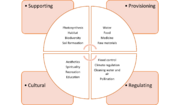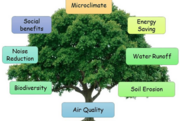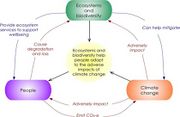BaCCC/Module 6/Lesson 3/Part 3
The importance of ecosystem services (“nature’s gifts”) in human resilience
Ecosystem services are the benefits that humans receive from natural ecosystems – nature – such as clean air and water, food and fibre, climate regulation and recreation. These services, which we often take for granted, are crucial for human well-being and survival and play a key role in maintaining a healthy and functional planet.
Ecosystem services are provided by a wide range of ecosystems, from forests and wetlands to oceans and coral reefs. They are shaped by the interactions between the biotic (living) and abiotic (physical) components of an ecosystem, as well as by human activities that can impact the health and function of these systems.
Human activities such as deforestation, urbanisation and pollution can exacerbate the impacts of climate change (and vice versa) and further degrade ecosystem services. It is crucial for us to take action to mitigate and adapt to the impacts of climate change to protect the ecosystem services that are so essential for our well-being and survival.
|
1. Provisioning services provide us with things like food (fruits, vegetables and nuts), water, timber, fuel and medicines. This is the simplest example of a service provided by nature. Agriculture, fishing and forestry all rely on the provisioning of resources from ecosystems, for example:
2. Regulating services regulate environmental processes that make life possible. Bees pollinate flowers, plants clean air and filter water, bacteria decompose wastes, and tree roots hold soil in place to prevent erosion. Ecosystems also regulate the climate by regulating temperature and the water cycle (unfortunately, our added greenhouse gas emissions are disrupting both of these). The following processes work together to make ecosystems clean, sustainable, functional and resilient to change:
3. Cultural services provide non-material benefits for our cultural, intellectual, social and spiritual development. These are the services associated with art and creativity, recreation and tourism, and spiritual and religious values. Examples include music and art, scenic beauty, cultural heritage sites, hiking and birdwatching.
4. Supporting services are the ones that we do not notice because we cannot see them. They happen invisibly (like photosynthesis) or underground (such as the creation of soil). These are the services that enable other ecosystem services to function, allowing Earth to sustain life. Examples of these services are
|
|
The graphic below shows in how many ways climate change can impact just one ecosystem (farmland) and one ecosystem service (food provision).
As you can see, if we do not respect the rest of Nature (remember, we are part of Nature too), we will lose the gifts and services that nature gives us. And so will the rest of life on Earth.
Robert Costanza, an ecological economist (someone who integrates ecological thinking with economics), and his team wanted to measure how much we, as a species, depend on ecosystems and the goods and services they provide. In their now-famous paper, “The Value of the World’s Ecosystem Services and Natural Capital,” they tried to estimate for the first time the magnitude of the contribution of ecosystem services and natural capital (the world’s stock of natural resources) to overall human well-being.
What they discovered shocked the world. In 1997, the estimate was US$33 trillion per year, which was nearly double the global gross national product of $18 trillion that year. Then a 2011 update suggested that ecosystems actually provide the equivalent of US$125 trillion or more in services per year. And we have never had to pay Mother Nature anything in exchange.
Let’s have a close look at one element, found in many ecosystems, that provides several of nature’s gifts: trees.
|
To help us understand the enormous value of all the gifts we receive from the rest of nature, scientists and economists have worked out that trees are worth half a billion dollars (i.e., $500,000,000) to a large urban area. Researchers looked at ten megacities around the world where trees sequester carbon and reduce air pollution and stormwater runoff. It turns out that trees provide an average of $505 million in benefits to each megacity every year, or about $1.2 million per square kilometre of trees. Read: Trees Provide Ecosystem Services Worth $500 Million to the World’s Megacities[1] Think for a moment of everything you appreciate about trees. 1. What material things do trees provide? 2. What do they help regulate? 3. What do they support? 4. What non-material things do they contribute? Check out: |
|
1. Provisioning: Trees provide us with oxygen, food (fruit, nuts and medicinal mushrooms), fodder (animal food), fuel (firewood), fertiliser, fibre (some First Nations people in Canada traditionally made their clothing from cedar bark), timber, habitat for non-human animals, windbreak, noise reduction, privacy and energy savings. 2. Regulating: Trees take up and sequester carbon dioxide from the atmosphere, moderate the microclimate, clean the air and water, increase rain, keep moisture in the soil, control water loss, decrease erosion and flooding, reduce ground-level ozone and control dust. 3. Supporting: Trees cool our homes and communities, provide shade, contribute to healthy soils and support biodiversity, pollinators and the human economy. 4. Cultural: Trees gift us with beauty, a sense of wilderness, healing, spiritual inspiration, recreation, fun, jobs and learning. |
Can you think of any others? (Jot them down in your learning journal so they are not forgotten.)
A typical tree can, on average, have a monetary value of nearly $200,000! A committee appointed by the Supreme Court of India determined that a tree is worth 74,500 Indian rupees per year multiplied by its lifespan. A heritage tree with a lifespan of well over 100 years could be worth more than 7 million rupees, according to the five experts on the committee.
The carbon cycle is the process by which carbon atoms are exchanged between the atmosphere, land and oceans. It is a critical component of the Earth’s climate system and plays a crucial role in regulating the amount of carbon dioxide in the atmosphere. Carbon sinks are natural or human-made systems that remove and store carbon from the atmosphere. They are important because they help to regulate the amount of CO2 in the atmosphere, which, in turn, helps to mitigate the impacts of climate change. Forests are a major land carbon sink (along with soil, grasslands and permafrost).
Maintaining and enhancing carbon sinks is an important strategy for mitigating climate change and reducing the amount of CO2 in the atmosphere while also adapting to the impacts. One main way to do this is by ending deforestation while also practising reforestation, afforestation (planting trees where they did not exist before), proforestation (letting an existing forest grow to its full maturity to get the full benefits from it) and the conservation of existing forests. If you have ever sat under a leafy tree on a hot day, then you know the value of trees in helping us adapt to the ravages of climate change.
See:
Land – The Planet’s Carbon Sink[3]
|
The time has come to recognize pollinators as guardians of the biological integrity of ecosystems and as a critical component to [a] nation’s economy. Many of our fruits, vegetables, and nuts, as well as other food products, rely on pollinators for reproduction or to increase crop yields. Pollinators with their wide foraging range and collecting activities are valuable perennial mobile biomonitors of the local environment. (Mattu, cited in Sarin, 2012) According to Professor Mattu, over 75% of the world’s major crops and 80% of all flowering plant species rely on animal pollinators, of which 73% are bees, 19% are flies and the rest are bats, beetles, birds, butterflies and moths. According to the United Nations, this represents 5% to 8% of global agricultural production. A recent United Nations biodiversity report warned that populations of bees, butterflies and other pollinating species could face extinction due to habitat loss, pollution, pesticides and, of course, climate change. Climate change is impacting native pollinators (solitary bees and bumblebees) in agricultural ecosystems. Warmer temperatures and extreme precipitation can reduce reproduction rates and increase pollinator deaths. Changes in plant−pollinator interactions, such as plants starting to bloom when pollinators are not active, can also occur. Add monocultural (only one crop) agriculture (with its lack of biodiversity), as well as pesticides and herbicides, and we can see that our food security is threatened. It is important to note that major grain crops are self-pollinated or pollinated by the wind. Some grain crops, such as canola, sunflower and fava beans, have a significantly higher quality and quantity of crop produced when insect pollination occurs. And a variety of other grain crops, such as field peas, safflower, lentils, sorghum, soybeans and other oilseed grain crops, such as linseed and flax, have been shown to receive some benefit from insect pollination. Himanchal Pradesh is known as the fruit state of India, and apple farming plays a major role in the economy of the state. Farmers estimate that apple productivity in Himanchal Pradesh had been declining continuously for the past few years. Factors affecting productivity of apples in Himanchal Pradesh are: 1. changes in the climate, which lead to less resilience of plants and insects to 2. disease and pest attacks, which decreases the number of pollinators and lead to 3. a lack of pollination. The majority of Himanchal Pradesh farmers believe that a lack of proper apple blossom pollination was one of the important factors in the declining apple productivity. The possible reasons for pollination failure include 1. unfavourable climatic factors, leading to 2. a scarcity of natural insect pollinators (bees), leading to 3. a lack of the appropriate ratio of pollinators to pollinisers (plants that provide the pollen, in this case the apple trees) Now that they are aware of the problem, farmers are starting to use different strategies to manage pollinisers and pollinators. Both pollinator bees and apple production have increased. For years in Hanyuan County, in the province Sichuen, China, often called the pear capital of the world, farmworkers have been hand-pollinating the white pear blossoms with brushes. Because the native bee populations have all but disappeared in this region (due to pesticide overuse), each individual blossom has to be pollinated by hand to produce a pear. Using pollination sticks – thin bamboo poles with a brush at the end made from chicken feathers or cigarette filters – the workers try to dab each flower. Picture how many more pear blossoms can be visited by tiny bees who have been doing this for 130 million years versus farmworkers standing on ladders trying to reach! Pollinators are our friends, and we need to conserve them. |
So, how do we repay our debt to Mother Nature?
(You can adjust the playback speed and/or turn on subtitles/captions.)
H5P Object Parameters
The H5P parameters below will be replaced by the actual H5P object when it's rendered on the WordPress site to which it's been snapshotted.
| “ | Healthy ecosystems are more resilient to climate change and provide life-critical services such as food and clean water. By restoring degraded ecosystems and effectively and equitably conserving 30% to 50% of Earth’s land, freshwater and ocean habitats, society can benefit from Nature’s capacity to absorb and store carbon, and we can accelerate progress towards sustainable development. | ” |
| —Hans-Otto Pörtner, IPCC Working Group II Co-Chair in UN News (2022), IPCC Adaptation Report A Damning Indictment of Failed Global Leadership on Climate | ||
In the same report, United Nationis Secretary-General António Guterres said, “As climate impacts worsen – and they will – scaling up investments will be essential for survival. Adaptation and mitigation must be pursued with equal force and urgency.”
Indeed, as we lower our personal greenhouse gas emissions as much as possible and help to create the political will for our governments and large industries to mitigate the rest, our other job is adapting to climate change. And because ecosystem services play an important role in protecting us from climate change, probably our most important adaptation strategy on a large scale is doing everything we can to protect and restore the ecosystems that sustain us.
Inger Andersen (2023), the head of UNEP agrees that protecting and strengthening mature is vital if we want to avoid global climate catastrophe. She suggests that we “let Nature do its job” – [Mother Nature] can’t keep taking the hits and treating the wounds. Soon those wounds will be too deep, too catastrophic, to heal. We need to soften and slow the blows by cutting greenhouse gas emissions. But we also need to cushion the blows by picking up our efforts to adapt to climate change – which have been too weak for too long.
The best way to ‘soften the blow’ is to let Nature do the job it spent millions of years perfecting. Absorbing and channelling rainwater and surging waves. Maintaining biodiversity and balance in soils so that diverse plants can grow. Providing cooling shade under leafy canopies. We need large-scale ecosystem restoration from ocean to mountaintop.
We need to bring Nature into baking hot cities to keep them cool. We need to conserve mangroves, coral reefs and Nature’s other defences. We need to protect and restore wetlands for Nature and incorporate wetlands in our cities. (Andersen, 2023)
|
Here are some other sources on ecosystem-based adaptation or nature-based solutions:
- The interactive map in the source “UNEP Ecosystem-based Adaptation”
- The US Environmental Protection Agency lists ecosystem protection strategies for climate change. You might find your ecosystem in this source at:
Ecosystem Protection Strategies for Climate Change[5]
- This source supplies some helpful graphics: “Ecosystem Services and Climate Change” by Bruno Locatelli, in Routledge’s Ecosystem Services and Climate Change, at:
Ecosystem Services and Climate Change[6]
- The aim of the report Harnessing Nature to Build Climate Resilience: Scaling up the Use of Ecosystem-based Adaptation is to “highlight the opportunities for scaling up the use of EbA [ecosystem-based adaptation] to help put the world on a more climate-resilient and nature-positive pathway.”
Harnessing Nature to Build Climate Resilience: Scaling up the Use of Ecosystem-based Adaptation[7]
- Find your ecosystem and possible adaptation strategies for it in the source Integrating Ecosystem-based Adaptation in Education Curriculum: A Resource Guide, at:
Integrating Ecosystem-based Adaptation in Education Curriculum: A Resource Guide[8]
And now, with a good understanding of climate adaptation strategies under your belt, it is time for the final module of this course, which will solidify your commitment to becoming a climate champion.
References
- ↑ Mongabay, 2017. Trees Provide Ecosystem Services Worth $500 Million to the World’s Megacities
- ↑ EFI Int, n.d. Forest Benefits
- ↑ United Nations, n.d. Land – The Planet’s Carbon Sink
- ↑ UNEP. n.d. Ecosystem-based Adaptation
- ↑ US EPA. n.d. Ecosystem Protection Strategies for Climate Change
- ↑ Locatelli. n.d. Ecosystem Services and Climate Change
- ↑ UNEP. n.d. Harnessing Nature to Build Climate Resilience: Scaling up the Use of Ecosystem-based Adaptation
- ↑ EBA South. n.d. Integrating Ecosystem-based Adaptation in Education Curriculum: A Resource Guide





